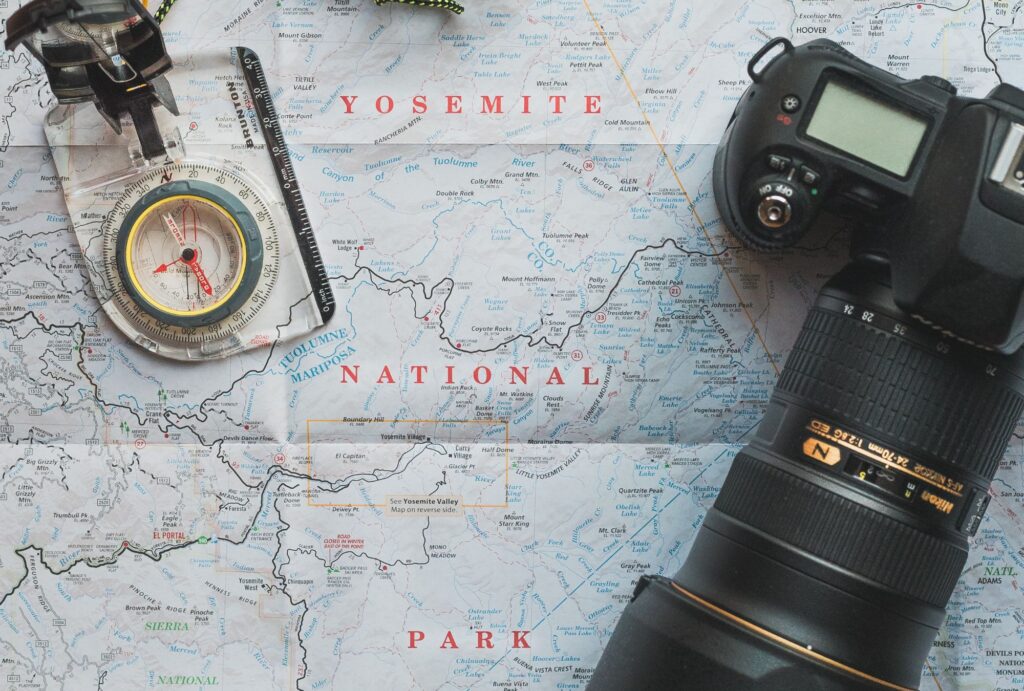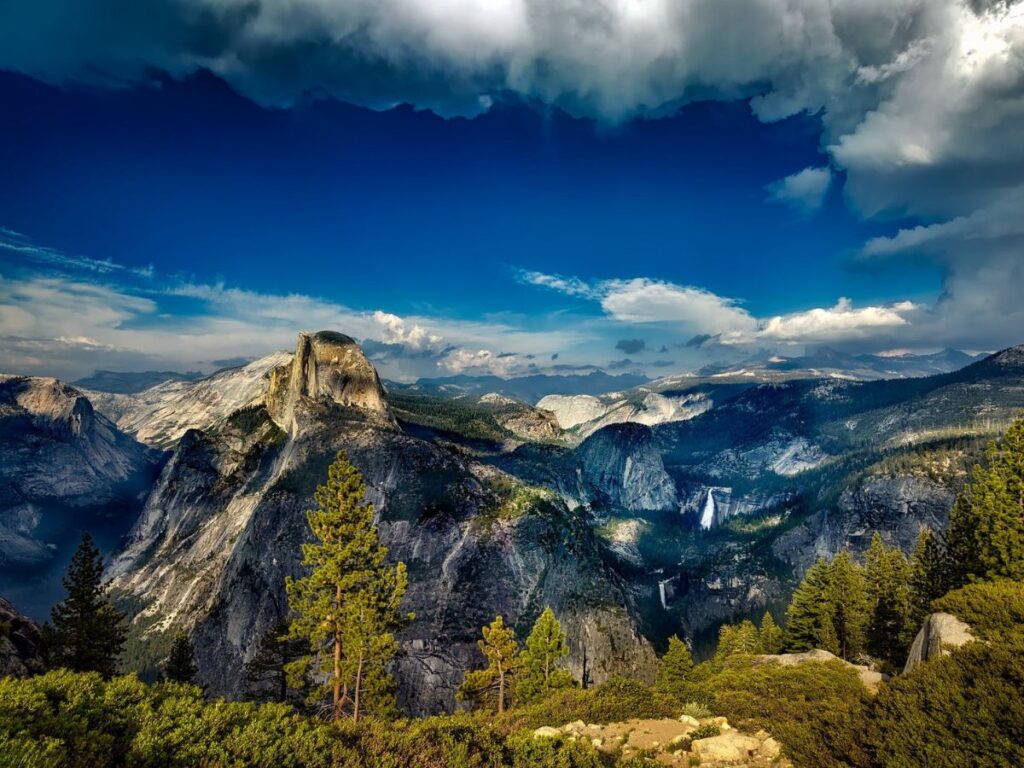Yosemite National Park is one of the United States’ most cherished natural treasures. As a popular destination, it annually welcomes millions of visitors from around the globe. With its captivating granite cliffs, ancient sequoias, and mesmerizing waterfalls, the park offers an unforgettable experience. Whether you’re a nature enthusiast or just looking for a serene getaway, Yosemite promises a blend of adventure and tranquility.
What is Yosemite National Park?
Established on October 1, 1890, Yosemite National Park spans an impressive area of over 1,187 square miles. Its rich history dates back to when Native Americans, the park’s original inhabitants, lived and thrived in this majestic landscape. It was later preserved and championed by influential figures like naturalist John Muir and President Theodore Roosevelt.
The significance of Yosemite cannot be overstated. Apart from its sheer beauty, it’s a UNESCO World Heritage Site, emphasizing its global importance for biodiversity and its geological and glacial marks. Main attractions include El Capitan, an imposing granite monolith; the towering Bridalveil Fall; and the iconic Half Dome. Beyond these, visitors are also drawn to its vast wilderness areas, deep valleys, grand meadows, and ancient giant sequoias, especially in the Mariposa Grove.

Where is Yosemite National Park Located on map?
Although it’s one of the most famous National Parks, however, if you are someone new or tourist, then you might be wondering: Where is Yosemite National Park Located on a map? Situated in the heart of California, Yosemite National Park graces the Sierra Nevada Mountain range. The park’s vastness stretches across several regions of the state. For those seeking reference points, major landmarks include Mariposa, Merced, and Oakhurst – towns that provide convenient gateways to different sections of the park. Notably, Yosemite is just a few hours’ drive from major cities such as San Francisco, making it an accessible yet transformative escape from urban life.
Ways to Get to Yosemite National Park
Yosemite National Park’s pristine beauty draws visitors from all corners of the globe. While its remote location amidst the Sierra Nevada Mountains ensures its serenity, getting there is relatively straightforward. Here’s a guide to help you choose the best travel option.
By Air
Several airports serve as gateways to Yosemite, offering both convenience and choice:
- Fresno Yosemite International Airport (FAT): Located approximately 1.5 hours from the park’s south entrance, this is the closest major airport. With a range of rental car services, you can easily drive to the park after landing.
- Merced Regional Airport (MCE): Situated around 2 hours away from the park, Merced provides another convenient option, especially for those coming from western regions.
- Sacramento International Airport (SMF): For those coming from further afield, Sacramento’s airport is roughly 3 hours away, offering a scenic drive into the heart of Yosemite.
By Car
Driving remains a popular and flexible option, offering the freedom to explore the park at your own pace. Key routes include:
- Highway 140 (Arch Rock Entrance): Coming from Merced and the western regions, this is a direct and scenic route.
- Highway 120 (Big Oak Flat Entrance & Tioga Pass Entrance): Ideal for those traveling from the San Francisco Bay Area and regions to the north, or from the east through Lee Vining during the summer months when Tioga Pass is open.
- Highway 41 (South Entrance): For travelers from the southern regions, including Fresno.
By Public Transport
While driving offers flexibility, there are sustainable alternatives available:
- Amtrak and YARTS: Combining train and bus, you can travel with Amtrak to Merced, then switch to the Yosemite Area Regional Transportation System (YARTS) which runs buses directly into the park.
- Greyhound: This bus service also reaches Merced, where you can hop onto a YARTS bus.
- Local Bus Services: YARTS provides regular bus services from various locations around Yosemite, ensuring even those without cars can access the park’s wonders.

Park Entrances
If you are wondering where is the Yosemite National Park entrance? Well, with its vast expanse, the park offers multiple entrance points, each with its unique charm and features. Here’s a closer look at the main entrances to help you plan your visit seamlessly.
North Entrance (Big Oak Flat Entrance)
Located off Highway 120 from the direction of Manteca and Sonora, the Big Oak Flat Entrance is one of the park’s major gateways. Big Oak Flat Information Station is also here where you can gather essential details about the park, obtain maps, and get updated on current conditions. It has nearby access to the Big Oak Flat Road, which leads directly to Yosemite Valley, ensuring you’re quickly immersed in the park’s central attractions. North Entrance is in close proximity to campgrounds such as Hodgdon Meadow and campgrounds in Yosemite Valley.
South Entrance
Location of Yosemite National Park can be accessed from Highway 41 near the towns of Fresno and Oakhurst, the South Entrance is a primary access point for those coming from Southern California. Yosemite National Park’s South Entrance Station provides useful information for visitors. It has a direct route to the Mariposa Grove of Giant Sequoias, where you can marvel at some of the park’s oldest and largest trees. South Entrance gives access to Wawona and its historic hotel, the Wawona Hotel, and nearby attractions.
East Entrance (Tioga Pass Entrance)
Found on Highway 120 near Lee Vining, the Tioga Pass Entrance provides access from the eastern side of the Sierra. It’s important to note that this entrance is seasonal and typically open from late spring to early fall, depending on snow conditions. Tioga Pass Entrance Station is in the East Entrance where visitors can gather information. It has immediate access to the scenic Tioga Road, which offers breathtaking views of the park’s high country. East Entrance is in close proximity to Tuolumne Meadows, a popular location for hiking, picnicking, and appreciating the alpine beauty of Yosemite.
West Entrance (Arch Rock Entrance)
Another way to get to the location of Yosemite National Park can be from Highway 140 coming from Merced and Mariposa, the Arch Rock Entrance offers a direct and picturesque route to Yosemite Valley. Arch Rock Entrance Station links to the West Entrance where you can collect valuable details and updates about the park. It also has a scenic route that follows the Merced River, providing captivating views as you approach the heart of Yosemite. There is swift access to Yosemite Valley’s array of landmarks, including El Capitan, Bridalveil Fall, and more.
Each entrance to Yosemite National Park holds the promise of different experiences and vistas. Your choice of entrance can set the tone for your entire visit, so consider your plans, the attractions you want to see, and the convenience of your chosen route.

When to Visit
Yosemite National Park is a dynamic landscape, with each season presenting unique experiences and challenges.
- Spring (March to May): As the snow melts, the park’s waterfalls are at their most spectacular. Wildflowers begin to bloom in the valleys. However, some high-elevation areas remain closed due to snow.
- Summer (June to August): The most popular time to visit. All areas of the park, including high-altitude regions like Tuolumne Meadows, are accessible. However, expect large crowds and be prepared for warm temperatures.
- Fall (September to November): Cooler temperatures bring a change in foliage, painting the park in warm autumnal hues. While waterfalls might be less vigorous, it’s a serene time to visit with fewer crowds.
- Winter (December to February): A magical season with snow-capped peaks and icy waterfalls. While the valley remains open, many parts of the park, like the Tioga Pass, close due to snow. Winter sports activities have become popular, but visitors should be prepared for cold temperatures.
Nearby Accommodations
For those wishing to stay near the park, there’s no shortage of options:
Hotels and Lodges: Inside the park, options like the Ahwahnee Hotel (formerly Majestic Yosemite Hotel) offer luxury accommodations. Yosemite Valley Lodge and Evergreen Lodge are other in-park choices with varying amenities.
Camping: For those looking to connect with nature, numerous campgrounds are spread throughout the park. Popular ones include Camp 4, Upper Pines, and Tuolumne Meadows. Reservations are recommended, especially during peak season.
Outside the Park: Nearby towns such as Mariposa, El Portal, and Oakhurst provide additional lodging options, from motels to bed and breakfasts.
What to Bring
Proper preparation ensures a smooth and enjoyable experience:
- Pack layered clothing. Even in summer, temperatures can vary significantly from day to night. Waterproof gear is advisable, especially in spring.
- While the park has signs, having a detailed map can help in exploring lesser-known areas. You can get these at entrance stations or visitor centers.
- Always carry water to stay hydrated. Pack some snacks, but ensure you store them properly to avoid attracting wildlife.
- Sunscreen, hats, and sunglasses are crucial, especially during summer.
- Sturdy hiking shoes or boots are essential if you plan to explore trails.
- Basic items like band-aids, pain relievers, and any personal medications.
- If camping, it’s mandatory to store food in bear-proof containers.
Key Takeaways
- Yosemite National Park is situated in California’s Sierra Nevada Mountains. It has multiple entrances, with routes accessible by air, car, and public transport.
- The park offers distinct experiences in each season, from spectacular waterfalls in spring to snow-capped vistas in winter. Summer is the busiest season with full park accessibility.
- Visitors can choose from in-park luxury hotels like the Ahwahnee, lodges, or campgrounds. Additional lodging options are available in nearby towns.
- Depending on the season and activities planned, visitors should pack appropriate clothing, maps, snacks, sun protection, and other essentials.
- Proper food storage, especially in bear-proof containers, is essential when camping to avoid attracting wildlife.
FAQs
- When is the best time to see the waterfalls?
Springtime, as snow melts. - Is the park open in winter?
Yes, but some areas like Tioga Pass close due to snow. - Are there luxury accommodations inside the park?
Yes, notably the Ahwahnee Hotel. - What footwear is recommended for hiking?
Sturdy hiking shoes or boots. - Which entrance offers the quickest access to Yosemite Valley?
The West (Arch Rock) Entrance. - What unique experiences does fall offer?
Cooler temperatures and warm autumnal hues with fewer crowds. - Which airport is closest to Yosemite?
Fresno Yosemite International Airport. - Are pets allowed in Yosemite?
Yes, but with restrictions. Always check current guidelines. - Which highway leads to the North entrance?
Highway 120 from Manteca and Sonora. - Where is Yosemite National park?
Yosemite National Park is located in the Sierra Nevada Mountains of central California, USA. - What city is Yosemite National Park located in?
Yosemite National Park isn’t located within a city, but the nearest town is Oakhurst. - Where is Yosemite National Park located?
It’s located in the eastern central region of California in the Sierra Nevada Mountains. - Where is Yosemite National Park in California?
In the eastern central part of California, within the Sierra Nevada Mountains. - Is Yosemite near San Francisco?
Yes, Yosemite is about a 4-hour drive southeast of San Francisco. - What state is Yosemite National Park in?
Yosemite National Park is in California.
